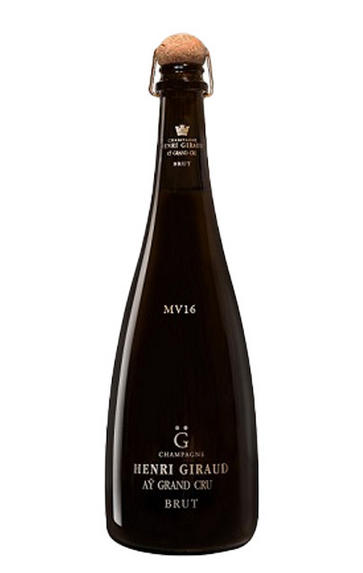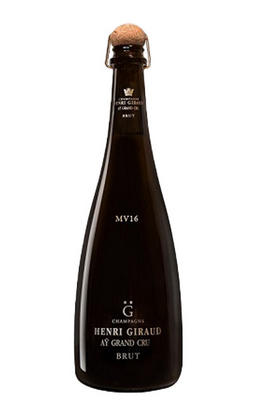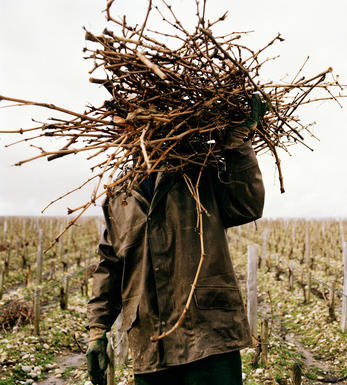
Champagne Henri Giraud, MV16, Grand Cru, Aÿ, Brut

Critics reviews
Drink 2022 - 2036
Antonio Galloni, vinous.com (Mar 2021)
80% Pinot Noir, 20% Chardonnay. The house's multi-vintage blend, based on the 2016 vintage deepened by the addition of one-third older wine from a perpetual reserve (solera system)
Deep gold. Not yet released but bursting with energy and interest. I'd very happily drink this now. There is real structure to this wine. Edgy but satisfying, and should probably appeal to a wider range of wine drinkers than the defiantly oak-influenced Argonne. Really very fine.
Drink 2021 - 2028Jancis Robinson, jancisrobinson.com (Mar 2021)
Alison Napjus, Wine Spectator (Oct 2021)
James Suckling, jamessuckling.com (May 2021)
About this WINE

Henri Giraud Champagne
Claude Giraud is the 12th generation of the Giraud-Hémart family to preside over the family business and produce Henri Giraud Champagne in Aÿ.
The Henri Giraud Fût de Chêne is a blend of Pinot Noir and Chardonnay, using the 'Petit Pinot' clone of Pinot Noir which has been grown solely in Aÿ since 1804. The wine is 100% oak fermented, a practice not commonly used elsewhere in Champagne, the notable exponents being Bollinger (for their vintage Champagnes), Alfred Gratien and Krug.

Brut Champagne
Brut denotes a dry style of Champagne (less than 15 grams per litre). Most Champagne is non-vintage, produced from a blend from different years. The non-vintage blend is always based predominately on wines made from the current harvest, enriched with aged wines (their proportion and age varies by brand) from earlier harvests, which impart an additional level of complexity to the end wine. Champagnes from a single vintage are labelled with the year reference and with the description Millésimé.
Non-vintage Champagnes can improve with short-term ageing (typically two to three years), while vintages can develop over much longer periods (five to 30 years). The most exquisite and often top-priced expression of a house’s style is referred to as Prestige Cuvée. Famous examples include Louis Roederer's Cristal, Moët & Chandon's Dom Pérignon, and Pol Roger's Cuvée Sir Winston Churchill.
Recommended Producers : Krug, Billecart Salmon, Pol Roger, Bollinger, Salon, Gosset, Pierre Péters, Ruinart

Champagne blend
Which grapes are included in the blend, and their proportion, is one of the key factors determining the style of most Champagnes. Three grapes are used - Pinot Noir, Chardonnay and Pinot Meunier.
26% of vineyards in Champagne are planted with Chardonnay and it performs best on the Côtes des Blancs and on the chalk slopes south of Epernay. It is relatively simple to grow, although it buds early and thus is susceptible to spring frosts. It produces lighter, fresher wines than those from Burgundy and gives finesse, fruit and elegance to the final blend. It is the sole grape in Blancs de Blancs, which are some of the richest long-lived Champagnes produced.
Pinot Noir accounts for nearly 40% of the plantings in Champagne and lies at the heart of most blends - it gives Champagne its body, structure, strength and grip. It is planted across Champagne and particularly so in the southern Aube district.
The final component is Pinot Meunier and this constitutes nearly 35% of the plantings. Its durability and resistance to spring frosts make the Marne Valley, a notorious frost pocket, its natural home. It ripens well in poor years and produces a soft, fruity style of wine that is ideal for blending with the more assertive flavours of Pinot Noir. Producers allege that Pinot Meunier lacks ageing potential, but this does not deter Krug from including around 15% of it in their final blends.


Buying options
Add to wishlist
Description
The backbone of Henri Giraud’s selection, the MV wines express their particular vintage whilst also maintaining the Giraud style. Fermented in oak.
80% Pinot Noir, 20% Chardonnay, with a third of the base wine coming from the 2016 vintage. This is a wonderfully, rich, complex vinous champagne. On the nose you are hit with layers of strawberries and cream, mixing with almonds and citrus notes, then warm toasty buttery notes to finish. On the palate the racy acidity holds up the rich texture. The bouche is soft and persistent with notes of apricots, honey, lemon tart, smoke and strawberries all culminating into a long toasty finish which lingers beautifully and persistently. Drink now – 2040.
Tara Field, Private Account Manager, Berry Bros. & Rudd (Oct 2021)
wine at a glance
Delivery and quality guarantee